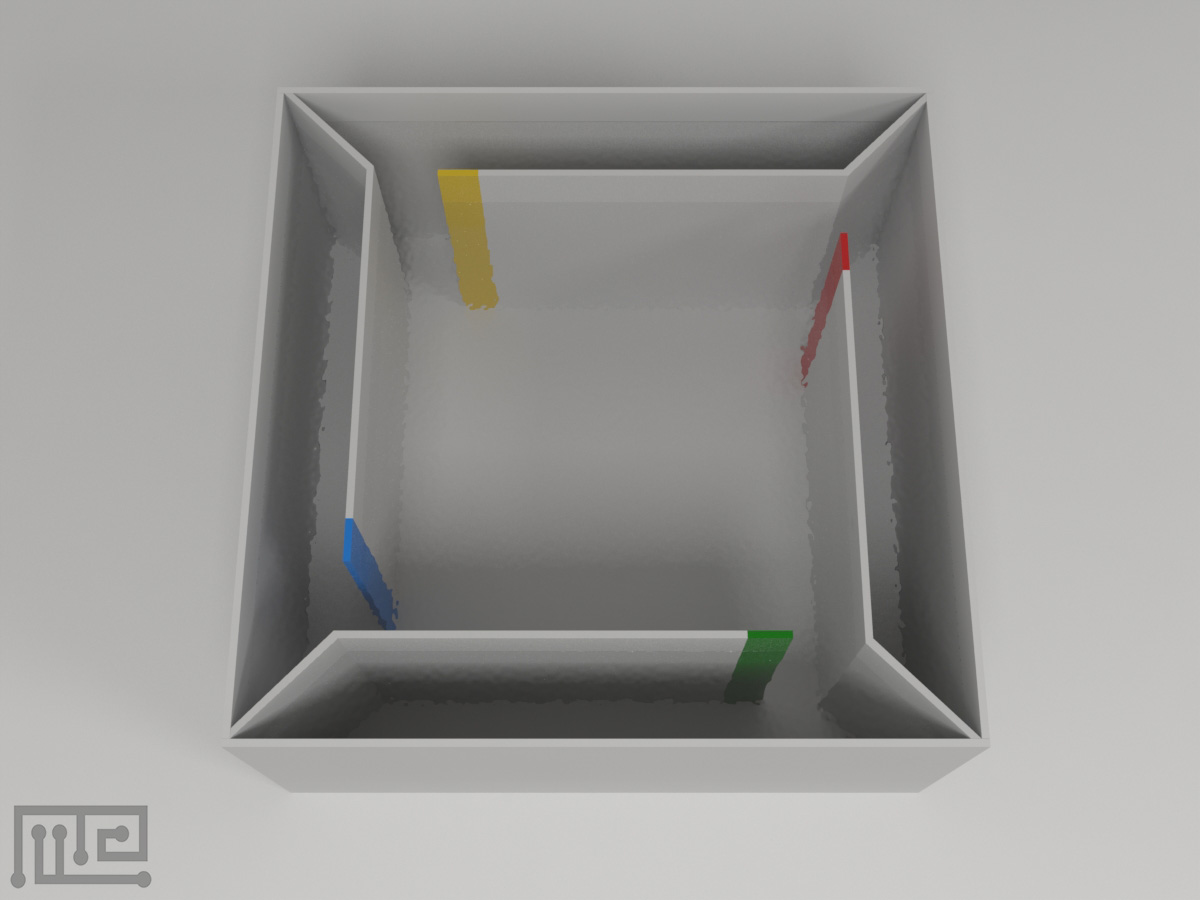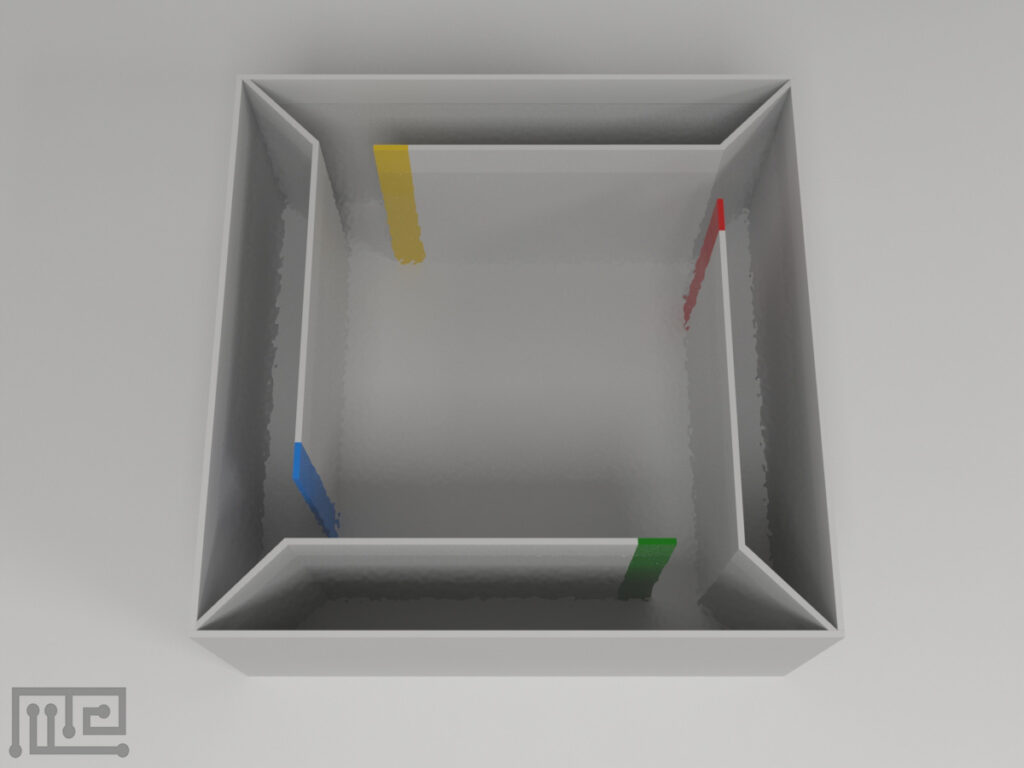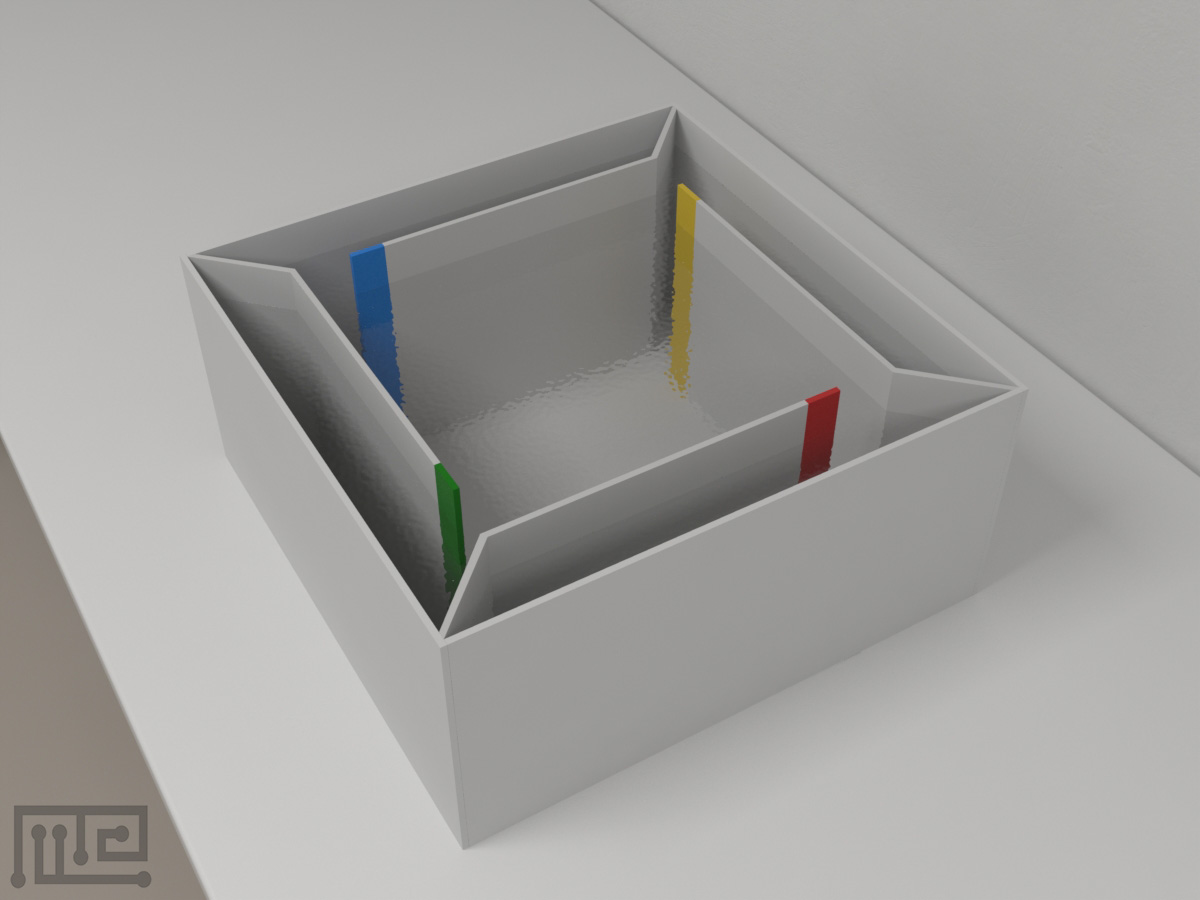The Predation Pressure Apparatus was used by Culum Brown et al. (2004), to assess the effects of predation pressure on the cognitive ability of the poeciliid Brachyraphis episcopi.
The maze apparatus consisted of a central compartment with four doors leading to four fringing compartments. Adjacent to each door, a colored marker (blue, red, green, and yellow) was placed to provide a discrete landmark to label each door.
The fish’s task was to locate the compartment containing the foraging patch. Fish were not offered food at any time other than when in the maze and were therefore motivated to discover the patch.
Fish from low-predation sites solved the spatial task of discovering the foraging patch almost twice as quickly as fish from high-predation areas.
Price & Dimensions
Predation Pressure Apparatus
$ 1790
+S&HLength of central compartment: 33cmWidth of central compartment: 33cm
Width of compartment doors: 5cm
Length of maze tank: 46cm
Width of maze tank: 46cm
Depth of water in tank: 18cm
Documentation
Introduction
The Predator pressure apparatus is used in the assessment of the cognitive functions of fishes. Learning and memory capabilities play an important role in the survival of any species. Fish behaviors can be influenced by a range of factors such as environmental factors like water temperature and rearing environments (Brignon et al., 2018), and social influences (Lemasson et al., 2018). In the wild, differences in predation pressure experienced by fishes in their environment also heavily modulate their behaviors (Brown, Gardner, & Braithwaite, 2005). The spatial maze, also known as the five chambered maze, is a common choice in the assessment of behavioral accommodations arising from predator pressure or the lack of it. Fishes have also been observed to display emotion-like states, suggesting the capacity for individual perception (Cerqueira et al., 2017), which can be evaluated in this spatial maze.
The Five Chambered Maze is designed to create four-choice chambers that the fish can enter from a central chamber. This design allows the experimenter the flexibility to apply different behavioral protocols by varying the environmental settings of the chambers. Additionally, the walls of the choice chambers are opaque, which forces the fish to enter a choice chamber to view its content. The apparatus can be applied to evaluate learning and memory protocols by placing a single stimulus in one of the choice chambers and changing its position as trials progress. Landmarks, such as colored tile at the choice chamber entrance, are often used in protocols applied in the Five Chambered Maze.
When used as a Predator Pressure Apparatus, the assay allows insights into stress and fear-related behaviors. Fishes from high and low predator pressure environments tend to have differences in their anti-predator behaviors (Bierbach et al., 2013; Kelley & Magurran, 2003). Apart from observing experience-based learning, the Predator Pressure Apparatus is also useful in observing innate anti-predator behaviors to understand the genetic basis of these behaviors.
Apart from learning and navigation protocols, social behaviors such as mating preference, shoal preference, and predator-prey interactions can also be observed using the Five Chambered Maze. Other apparatuses used in the assessment of fish behaviors include the Latent Learning Apparatus, Zebrafish 5-Choice Apparatus, Zebrafish T-Maze, and Mirror Biting. For Cephalopod behavioral assays, click here.
Apparatus and Equipment
The Five Chambered Maze is constructed using a glass aquarium measuring 46 × 46 cm. The central compartment measures 33 × 33 cm and has 5 cm wide doors on each side wall that lead to the fringing compartments. The dividing walls are opaque to prevent the subject from viewing into the choice chambers. The apparatus also comes with a removable, clear start cylinder to confine the subject prior to initiation trials. A set of 2 × 2 cm colored markers (Red, Blue, Green, and Yellow) is also available.
Training Protocol
Ensure that the apparatus is appropriately lit, and the task is performed in an undisturbed environment to minimize the influence of any external stimuli on the performance. Tracking and recording of the performances can be done with the assistance of an external tracking and video system such as the Noldus EthoVision XT.
Fill the tank with at least 18 cm of water and maintain all environmental parameters throughout the trials.
Following is a sample protocol that can be applied using the Five Chambered Maze. Protocols and maze set-up will vary based on investigatory aims.
Spatial Learning Task
Separate the test subjects into individual holding cylinders before beginning trials. Place the landmarks at the entrances of the choice chambers. Place positive/negative reinforcement in one of the choice chambers. Maintain the landmark and reinforcement combination for all trials. Transfer the subject to the clear start cylinder in the center of the central chamber. Allow it 2 minutes to acclimatize, following which remove the cylinder to release the subject.
Observe the fish behavior for 10 minutes or until it has reached the correct chamber. If it enters the correct chamber, allow it 30 seconds of exploration before recapturing it.
Perform one trial per day with the landmark and reinforcement combination rotated between the choice chambers.
Literature Review
Investigation of the effects of rearing conditions on spatial cognition of Zebrafish
Spence, Magurran, and Smith (2011) investigated two strains of Zebrafish; WIK obtained as eggs from the Tubingen zebrafish stock center and Wild-types; for the effects of different rearing conditions on spatial cognition. Test fishes were reared in a simple or a complex rearing environment, which resulted in WIK simple, WIK complex, Wild simple, and Wild complex groups. The complex environment tank was enriched with 50 artificial Elodea canadensis of length 50 mm, while the simple environment was a bare aquarium. All groups were subjected to learning rate testing in the Five Chambered Maze. The maze was set-up with a marker placed adjacent to the entry of the chamber consisting of the feeding ring. Three fishes from each group were tested individually in the apparatus in trials lasting 10 minutes, once daily for seven days. Fish were introduced into the start cylinder and allowed 2 minutes to acclimate, following which they were released, and on finding the feeding ring, they were allowed two minutes to consume the reward. At the end of the seven days, fishes continued to remain in their respective groups and were retested 10 days later over three consecutive days. A significant effect of body length was observed with larger fishes showing shorter latency to feed. In addition to being larger in sizes, fishes reared in the simple environment displayed a slower rate of learning.
Investigation of the effects of predation pressure on Brachyraphis episcopi fish’s cognitive abilities
Brown and Braithwaite (2005) investigated the differences in the performances of Brachyraphis episcopi obtained from upstream low predation and downstream high predation site in the Predator Pressure Apparatus task. Six females from each group were housed in individual holding cylinders prior to the task. Colored markers were placed adjacent to the doors of the choice chambers in the order, Red, Green, Blue, Yellow. The reward chamber had a food ring that minimized the spread of the food reward and a plastic tree similar to the one in holding tanks. The rewards were paired with the blue marker, which was observed to be least preferred in the initial preference trials. During the trials, on one side of the maze, a white curtain was placed to minimize the influence of external traffic. The maze was, otherwise, not covered, and the subjects could use the extra-maze cues. Each subject was allowed 2 minutes to acclimatize in the start cylinder, after which they were released and observed for a period of 10 minutes. Trials were performed once per day over the course of 18 days. It was observed that the fish from the high predation site entered more doors in comparison to the low predation site fishes. However, the number of doors visited prior to entering the goal chamber reduced as trials progressed for both groups. A similar observation was observed in the number of incorrect doors entered. Since the maze design encourages an anticlockwise direction movement, the number of righthand turns was taken as the measure of undirected navigation. High predation site fish were observed to make more right-hand turns when emerging from any given door in comparison to their counterparts.
Investigation of orientation behavior in Amarillo fish
de Perera Burt and Macias Garcia (2003) investigated the ability of Amarillo fish to use visual landmarks to locate the rewarded chamber in the Five Chambered Maze. The investigation was performed using 40 male and female Amarillo fish from two ecologically different sources; one group was selected from a turbid shallow lake while the other was obtained from a clear mountain lake. Additionally, shoals composed of two of each male and female were confined to a clear glass cylinder and used as the reward during the trials. Empty glass cylinders were placed in the remaining three cylinders. The shoal holder prevented any olfactory and tactile stimuli. Test fishes were divided into two groups: visual landmark and no visual landmark groups. The group tested with the visual landmark had colored markers placed adjacent to the entrances of the choice chambers. The combination of the reinforcement, shoal, and the colored landmark was maintained throughout the trial. For each trial, the subject was allowed 30 seconds within the start cylinder following which they were released. Once the subject made its chamber choice, it was allowed 30 seconds to explore it before being recaptured. All test subjects were trained with the shoal positioned switched until they had learned to enter the correct chamber (average five releases). Testing was performed similarly to the training, and behaviors were recorded over 12 consecutive releases. Test fishes were once again subjected to the Five Chambered Maze training and testing 10 days later with the conditions reversed; fish trained with landmarks were trained without it and vice versa. Results revealed that regardless of the place of origin, all fishes performed better in the presence of visual cues. However, the improvement wasn’t significant. Fishes were also observed to stay close to the shoal glass jar and spend more time around it than when they encountered an empty glass jar. It was also observed that fishes from turbid eutrophic water performed better than those from the clear waters.
Data Analysis
The following observations and parameters can be recorded using the Five Chambered Maze
- Latency to initiate exploration
- Number of correct door entries
- Number of incorrect door entries
- Number of doors entered before entering the correct chamber
- Pattern of turns
- Percentage correct entries
- Percentage errors
- Average time spent in the correct chamber
- Time spent interacting with the reinforcement
- Rate of learning
Strength and Limitations
Strengths
The Five Chambered Maze is designed to encourage anticlockwise passive movement to increase the likelihood of apparatus familiarization. The clear start cylinder allows acclimation of the subject to the apparatus prior to beginning trials and can also be used to introduce inter-trial delays. The opaque walls of the central chamber prevent visual cues from the choice chambers from influencing performances. The four-choice chambers can be set-up to emulate different environments to observe fish responses.
Limitations
Over handling or improper handling of the subject can result in stress. Changes in environmental conditions during testing can influence the subject’s behaviors. The presence of any lingering stimuli can influence the observed behaviors. Factors such as age, gender, strain, and species can also influence observed results.
Summary
- The Five Chambered Maze is used in the assessment of fish cognition and behaviors.
- The apparatus consists of a central chamber with doors in the sidewalls leading to the choice chambers.
- The walls of the central chamber are opaque to prevent visual cues in the choice chamber from influencing fish behavior.
- The apparatus comes with a clear start cylinder that can be used to acclimate the subject to the apparatus.
- The Predation Pressure Apparatus is useful in investigating experienced-based and innate anti-predator behaviors.
- The Five Chambered Maze can be easily adapted for evaluation and investigation of social behaviors, navigation, and preference testing in fishes.
References
- Brown, C., & Braithwaite, V. A. (2005). Effects of predation pressure on the cognitive ability of the poeciliid Brachyraphis episcopi. Behavioral Ecology, 16(2), 482-487.
- Brignon, W. R., Pike, M. M., Ebbesson, L. O., Schaller, H. A., Peterson, J. T., & Schreck, C. B. (2018). Rearing environment influences boldness and prey acquisition behavior, and brain and lens development of bull trout. Environmental Biology of Fishes, 101(3), 383-401.
- Cerqueira, M., Millot, S., Castanheira, M. F., Félix, A. S., Silva, T., Oliveira, G. A., … & Oliveira, R. F. (2017). Cognitive appraisal of environmental stimuli induces emotion-like states in fish. Scientific reports, 7(1), 1-10.
- Lemasson, B., Tanner, C., Woodley, C., Threadgill, T., Qarqish, S., & Smith, D. (2018). Motion cues tune social influence in shoaling fish. Scientific reports, 8(1), 1-10.
- de Perera Burt, T., & Macias Garcia, C. (2003). Amarillo fish (Girardinichthys multiradiatus) use visual landmarks to orient in space. Ethology, 109(4), 341-350.
- Spence, R., Magurran, A. E., & Smith, C. (2011). Spatial cognition in Zebrafish: the role of strain and rearing environment. Animal cognition, 14(4), 607-612.
- Brown, C., Gardner, C., & Braithwaite, V. A. (2005). Differential stress responses in fish from areas of high-and low-predation pressure. Journal of Comparative Physiology B, 175(5), 305-312.
- Kelley, J. L., & Magurran, A. E. (2003). Effects of relaxed predation pressure on visual predator recognition in the guppy. Behavioral Ecology and Sociobiology, 54(3), 225-232.
- Bierbach, D., Schulte, M., Herrmann, N., Zimmer, C., Arias-Rodriguez, L., Indy, J. R., … & Plath, M. (2013). Predator avoidance in extremophile fish. Life, 3(1), 161-180.
Request a quote
"*" indicates required fields




